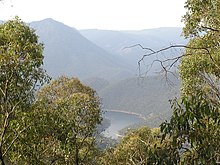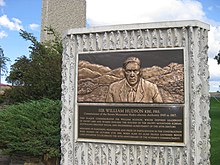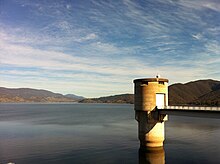Snowy Mountains Scheme

The Snowy Mountains scheme is a hydroelectricity and irrigation complex in south-east Australia. It consists of sixteen major dams; seven power stations; a pumping station; and 225 kilometres of tunnels, pipelines and aqueducts and was constructed between 1949 and 1974. The Chief engineer was Sir William Hudson. It is the largest engineering project undertaken in Australia.[1][2][3]
The Scheme's construction is seen by many "as a defining point in Australia's history, and an important symbol of Australia's identity as an independent, multicultural and resourceful country".[2]
How it works

The water of the Snowy Mountains Region is captured at high elevations and diverted inland to the Murray River and the Murrumbidgee River, through two tunnel systems driven through the Snowy Mountains.


The water falls 800 metres and travels through large hydro-electric power stations which generate peak-load power for the Australian Capital Territory, New South Wales and Victoria.[1][4]
The scheme is operated by Snowy Hydro Limited. Since corporatisation in 2002 Snowy Hydro operates as a Corporations Act company, owned by the New South Wales, Victorian and Federal Governments.[5]
History
Background
The Snowy Mountains Hydro-electric Power Act 1949[6] gave the Snowy Mountains Hydro-electric Authority, now called Snowy Hydro Limited, the responsibility for the final evaluation, design and construction of the Snowy Mountains Scheme. The plan was to divert the waters of the Snowy Mountains Region to provide increased electricity generating capacity and to provide irrigation water for the dry west. It was "greeted with enthusiasm by the people of Australia" and was seen to be "a milestone towards full national development".
The chief engineer, New Zealand-born William Hudson[7] (knighted 1955), was chosen to head the scheme as Chairman of the Snowy Mountains Hydro-electric Authority, and was instructed to seek workers from overseas. Hudson's employment of workers from 32 (mostly European) countries, many of whom had been at war with each other only a few years earlier,[8] had a significant effect on the cultural mix of Australia.
Snowy Mountains Hydro-Electric Scheme

Construction of the Snowy Scheme officially began on 17 October 1949 and took 25 years to complete. Tunneling records were set in the construction of the Scheme and it was completed on time and on budget in 1974, at a cost of $820 million. Around two thirds of the workforce employed in the construction of the scheme were immigrant workers, originating from over 30 countries. The official death toll of workers on the Scheme stands at 121 people. Some 1600 kilometers of roads and tracks had to be constructed, 7 townships and over 100 camps had to be built to enable construction of 16 major dams, 7 hydroelectric power stations, a pumping station, 145 kilometers of tunnel and 80km of pipelines and aqueducts. Just 2% of the construction work is visible from above ground.[9]
Some of the towns constructed for the scheme are now permanent: Cabramurra (the highest town in Australia); and Khancoban. Cooma flourished during construction of the Scheme and remains the headquarters. Townships at Adaminaby, Jindabyne and Talbingo were inundated by the construction of Lakes Eucumbene, Jindabyne and Jounama.[10][11][12] Improved vehicular access to the High Country enabled ski-resort villages to be constructed at Thredbo and Guthega in the 1950s by ex-Snowy Scheme workers who realised the potential for expansion of the Australian ski industry.[13][14]


The Scheme is in an area of 5,124 square kilometres, almost entirely within the Kosciuszko National Park. The design of the scheme was modelled on the Tennessee Valley Authority.[15]
The Scheme was managed by the Snowy Mountains Hydro-electric Authority, and took 25 years to build, from 1949 to 1974,[15] at the cost (at that time) of A$820 million; a dollar value equivalent in 1999 and 2004 to A$6 billion.[16][17] It employed over 100,000 people from over 30 countries in its construction, providing employment for many recently arrived immigrants, and was important in Australia's post-war economic and social development. Seventy percent of all the workers were migrants.[18]
During construction of the tunnels, a number of railways were employed to convey spoil from worksites and to deliver personnel, concrete and equipment throughout.[19]
The project used Australia's first transistorised computer; one of the first in the world. Called 'Snowcom', the computer was used from 1960 to 1967.[20]
At the completion of the project, the Australian Government maintained much of the diverse workforce and established the Snowy Mountains Engineering Corporation (SMEC), which still exists as an international engineering consultancy company. The Scheme is the largest renewable energy generator in mainland Australia and plays an important role in the operation of the national electricity market, generating approximately 67% of all renewable energy in the mainland National Electricity Market. The Snowy Scheme's primary function is as a water manager, however under the corporatised model must deliver dollar dividends to the three shareholder governments - the NSW, Commonwealth and Victorian Governments.
The Scheme also has a significant role in providing security of water flows to the Murray-Darling Basin. The Scheme provides approximately 2,100 gigalitres of water a year to the Basin, providing additional water for an irrigated agriculture industry worth about $3 bn per annum[2]., representing more than 40% of the gross value of the nation's agricultural production.
The Snowy Mountains Hydro-electric Scheme, is one of the most complex integrated water and hydro-electric power schemes in the world and is listed as a "world-class civil engineering project" by the American Society of Civil Engineers.[15] The scheme interlocks seven power stations and 16 major dams through 145 kilometres of trans-mountain tunnels and 80 kilometres of aqueducts. The history of the Snowy Scheme reveals its important role in building post World War II Australia.
Statistics
Construction of the Scheme began in 1949 and was completed in 1974. Guthega power station commenced power production on 21st February 1955. Lake Eucumbene is the largest reservoir in the Scheme. It has a foreshore of 250 km, with a capacity of 4.8 million megalitres (which is about nine times that of Sydney Harbour). At the other end of the scale, Deep Creek is the smallest reservoir with just 11 megalitres. Talbingo Dam has the highest wall at 161.5 metres, while Khancoban has the longest crest, at 1066.8 metres.[21]
Proposed sale
In late 2005 there was a proposal by the NSW government of Morris Iemma for the federal and state governments to sell their shares in Snowy Hydro Limited. Following public protest by farmers, environmentalists and a broad coalition, the Prime Minister John Howard withdrew support for the sale of the Federal Government's 13% share in the company in 2006. The NSW and Victorian Governments then withdrew from the proposed sale of their respective 58 per cent and 29 per cent shares in the company.[22][23]
Tourism


The Snowy Scheme is a major tourist destination. Sightseeing driving tours to the key locations of the Scheme are popular out of regional centres like Tumut, Adaminaby and Jindabyne along roads built for the Scheme like the Snowy Mountains Highway and Alpine Way and towards sights like Cabramurra (Australia's "highest town"), spectacular dam walls, and scenic lakes.
Trout fishing is popular in the lakes of the Scheme, notably Lake Jindabyne and Lake Eucumbene. The Snowy Scheme Museum opened at Adaminaby in 2011 to tell the history of the Scheme.[24]
Though Skiing in Australia began in the northern Snowy Mountains in the 1860s, it was the construction of the vast Snowy Scheme from 1949, with its improvements to infrastructure and influx of experienced European skiers among the workers on the Scheme that really opened up the Mountains for the large scale development of a ski industry, and led to the establishment of Thredbo and Perisher as leading Australian resorts.[25][26] The Construction of Guthega Dam brought skiers to the isolated Guthega district and a rope tow was installed there in 1957.[27] Charles Anton, a snowy worker identified the potential of the Thredbo Valley.
Environmental concerns
The original plan was for 99% of the water of the Snowy River's natural flow to be diverted by the Scheme below Lake Jindabyne. Releases from the Scheme were based on the needs of only riparian users and took no account of ecosystem needs; it soon became known that the lower reaches of the river were in environmental crisis. An extensive public campaign led to the Snowy Water Inquiry being established in January 1998. The Inquiry reported to the New South Wales and Victorian Governments in October of that year, recommending an increase to 15% of natural flows. The two Governments were equivocal about this target; aside from economic considerations there was a view that the health of the Murray is more important than that of the Snowy and any extra environmental flows are better used there instead.
In 1999 the seat of East Gippsland was won in the Victorian election by an independent Craig Ingram, based in large part on his campaign to improve Snowy flows. In 2000, Victoria and NSW agreed to a long-term target of 28%, requiring $375 million of investment to offset losses to inland irrigators. In August 2002 flows were increased to 6%, with a target of 21% within 10 years. However, by October 2008 it was evident that the return of environmental flows to the Snowy River in 2009 would be no more than 4% of natural flow with governments arguing the Snowy River needs to "pay back" the "Mowamba Borrowings".[1]
This article needs to be updated. (November 2010) |
Concerned water managers, conservationists, politicians and farmers continue to advocate for the return of environmental flows to the Snowy River. The Dalgety District and Community Association now holds an annual 'Snowy River Day' on 31 August to commemorate when the three governments, Victoria, NSW and the Commonwealth with high profile former Australian Conservation Foundation President, and now Federal Environment Minister Peter Garrett oversaw the temporary release of water from the Moonbah or Mowamba River, a tributary of the Snowy River. In accordance with the Snowy Water Licence, Snowy Hydro Limited has 're-commissioned' the Mowamba Aqueduct. Seasonal variable flows are essential to river ecology including flushing flows to support vital ecosystems for the Australian platypus[28] and native Australian Bass, the species over which Craig Ingram initially fought for flows into the Snowy River and achieved a seat as Independent for Gippsland East in the Victorian State Parliament.
A major spillway upgrade is now finished which will facilitate these flows.
Components

Power stations
As of 2006 there were seven core power stations. These are in chronological order :
- Guthega (60MW) - completed in 1955
- Tumut 1 (330MW) - completed in 1958
- Tumut 2 (286MW) - completed in 1961
- Blowering (80MW) - completed in 1967
- Murray 1 (950MW) - completed in 1967
- Murray 2 (550MW) - completed in 1969
- Tumut 3 (1500MW) - completed in 1974[29]
In the 21st century three smaller scale hydro developments have been constructed by Snowy Hydro. These take advantage of existing water sources around the scheme:
- Tumut 3 Micro Hydro (720kW) - completed in 2004
- Jounama Small Hydro (14.4MW) - completed in 2010
- Jindabyne Dam Mini Hydro (1.1MW) - construction started in 2011
Major lakes and reservoirs


| Body of water | Year completed |
|---|---|
| Talbingo Dam | 1970 |
| Lake Eucumbene | 1958 |
| Blowering Dam | 1968 |
| Geehi | 1966 |
| Tumut Pond Reservoir | 1959 |
| Lake Jindabyne | 1967 |
| Tooma Reservoir | 1961 |
| Island Bend | 1965 |
| Tumut 2 | 1961 |
| Tantangara Dam | 1960 |
| Jounama | 1968 |
| Murray 2 | 1968 |
| Guthega Dam | 1955 |
| Happy Jacks Pondage | 1959 |
| Deep Creek | 1961 |
| Khancoban | 1966[30] |
See also
References
- ^ a b Australian Bureau of Statistics 1986 Special Article: The Snowy Mountains Hydro-Electric Scheme
- ^ a b c The Snowy Mountains Scheme
- ^ Wendy Lewis, Simon Balderstone and John Bowan (2006). Events That Shaped Australia. New Holland. pp. 189–194. ISBN 978-1-74110-492-9.
- ^ Technology in Australia 1788-1988
- ^ http://www.snowyhydro.com.au/levelOne.asp?pageID=3
- ^ ComLaw: Snowy Mountains Hydro-electric Power Act 1949
- ^ The New Zealand Edge : Heroes : Builders : William Hudson
- ^ Australian Dictionary of Biography
- ^ Information plaque; Snowy Scheme Museum, Adaminaby; referenced April 2012.
- ^ "Adaminaby". The Sydney Morning Herald. 1 January 2009.
- ^ http://snowymountains.com.au/Jindabyne.html
- ^ http://snowymountains.com.au/Talbingo.html
- ^ http://www.thredbo.com.au/about-thredbo/history/
- ^ http://www.visitnsw.com/town/Guthega.aspx
- ^ a b c "Designated Historic Civil Engineering Landmarks". Heritage Knowledgebase Database. American Society of Civil Engineers. Listed 1997. Retrieved 2007-03-09.
{{cite web}}: Check date values in:|year=(help) - ^ Besley, M A (Tim) (1999). "The Need for Infrastructure Projects — Then and Now (an edited version of an address President Mr M A (Tim) Besley AO FTSE to the Alstom International Association (The Overseas Club) 11 August 1999, Sydney)". ATSE Focus No 109, November/December 1999. Australian Academy of Technological Sciences and Engineering (ATSE). Retrieved 9 March 2007.
{{cite web}}: Cite has empty unknown parameter:|coauthors=(help) - ^ Anderson, John (2004). "Transcript of the Acting Prime Minister media conference, 7 June 2004 — Subjects: AusLink, Peter Garrett, US relations, Iraq, Federal election". Ministers' speeches. Department of Transport and Regional Services (Australia). Retrieved 9 March 2007.
{{cite web}}: Cite has empty unknown parameter:|coauthors=(help) [dead link] - ^ "The Snowy Mountains Scheme". Culture and recreation portal. Department of the Environment, Water, Heritage and the Arts (Australia). 2008. Retrieved 20 July 2008.
- ^ Tunnel Railways of the Snowy Mountains Scheme Wright, H.J. & Shellshear, W.M. Australian Railway Historical Society Bulletin, September, 1971 pp193-210
- ^ "The Engineering". Snowy Mountains Scheme. Snowy Hydro Limited. 2007. Retrieved 20 July 2008.
- ^ Information plaque; Snowy Scheme Museum, Adaminaby; referenced April 2012.
- ^ Grubel, James. "Australian government scuppers Snowy Hydro sale". Reuters date=2 June 2006. Retrieved 2 June 2006.
{{cite news}}: Missing pipe in:|publisher=(help) - ^ "PM 'pulls rug' on Snowy sale". The Sydney Morning Herald. 2 June 2006.
- ^ http://www.abc.net.au/news/2011-10-17/snowy-scheme-museum-opens/3574192
- ^ http://www.thredbo.com.au/about-thredbo/history/
- ^ http://www.perisherblue.com.au/winter/info/history.html
- ^ http://www.christianacapital.com/Text/1201316577093-6700/
- ^ Snowy River National Park
- ^ Snowy Hydro
- ^ http://www.snowyhydro.com.au/LevelThree.asp?pageID=245&parentID=66&grandParentID=4
External links
- Construction Images
- Snowy Hydro Limited
- Snowy Mountains Hydro Electric Scheme slide collection with accompanying text / Laurence Failes — as digitised and held by the National Library of Australia
- Australian Bureau of Statistics: 1986 Year Book Australia Special Article — The Snowy Mountains Hydro-electric Scheme
- the Snowy River Alliance — a community group for the protection of the Snowy River
- The Snowy -The People behind the Power / Siobhan McHugh — An historic account about the multinational workforce that built the Snowy Mountain Hydro-Electric scheme
- Snowy Scheme collection at the National Museum of Australia
- Snowy Mountains Engineering Corporation (SMEC) History
- New Australia: The Snowy Mountains Hydro-Electric Scheme 1949-1974 online exhibition
